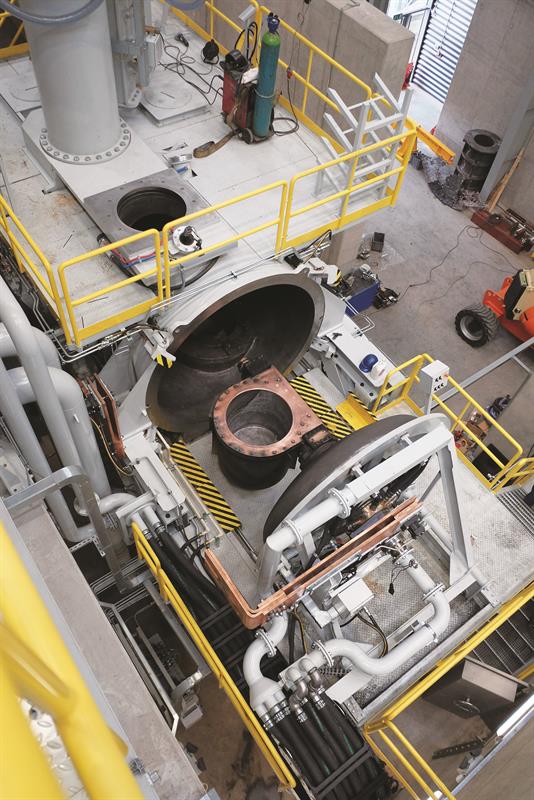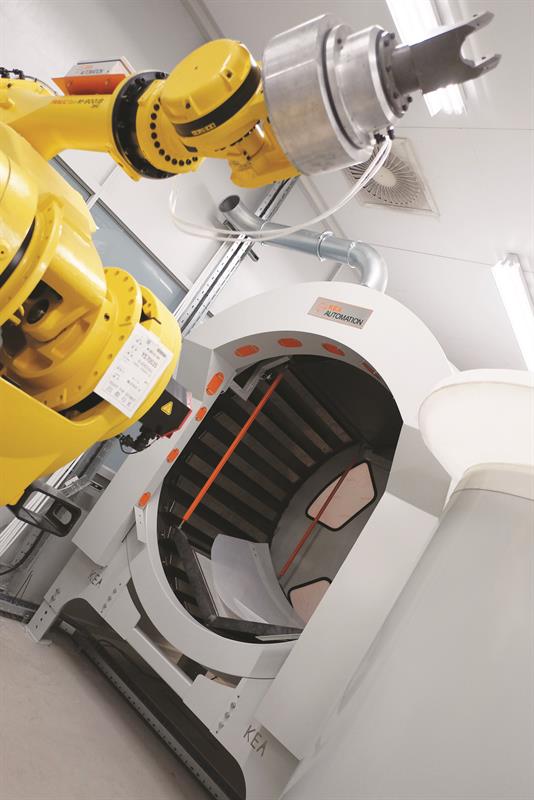Part of the University of Sheffield Advanced Manufacturing Research Centre (AMRC) with Boeing, AMRC Castings can now produce parts that weigh up to half a tonne, although it takes a pour of 1,000 kg to deliver that, due to retained material in the crucible, reservoirs and runners. The facility, which will commence operations this month with a first test part, has drawn funding for its foundry system and associated equipment from the UK’s government/industry-backed Aerospace Technology Institute (ATI). That investment is just over £15 million.
A research rather than a production facility, AMRC Castings’ key thrust is the development of knowledge to support the cost-effective manufacture of large aerospace titanium castings, with some of those substituting for the forged parts of today by being able to offer similar material properties, nearer to net shape. And the headline pay-off is a reduced fly-to buy ratio, which can reach 20:1 for forging and machining routes versus, conservatively, 2:1 for the cast near-net shape route that additionally allows for more complex part designs.
That label of research facility is important; there are four other companies in the world (three in America, one in Belgium) that have an equivalent casting capability, says AMRC Castings research and development manager Mark D’Souza-Mathew, but none is focused on research, all must pay their way in the commercial world, he stresses. In addition, there are technically unique elements about AMRC Castings’ facility and knowledge that relate to the achievement of, most importantly, improved material microstructure, plus the ability to design and make thinner wall, lighter, reliable, lower cost shells (moulds).
Of course, the expertise required to produce such massive castings, although smaller ones are also within the facility’s sights (250- and 500-kg pour capacity crucibles are also available), does not just magically appear; AMRC Castings’ work is a progression of that already carried out by Castings Technology International (CTI) and Titanium Castings UK, both of which were acquired by the University of Sheffield in 2013 (buildings and asset plus ongoing research work, commercial contracts and consultancy). These operations, which today have over 15 years of titanium casting experience, also offer low rate initial production and legacy part support (http://castingstechnology.com).
Both those existing activities were already on the Sheffield city region’s Advanced Manufacturing Park (AMP) where the AMRC with Boeing is also located. AMRC Castings was established in 2013 to add another strand to the acquired operations, but its new foundry, still undergoing final commissioning as at Machinery’s April visit, is housed in an extension to existing buildings. The business case for the new foundry set-up was, in fact, put to the ATI in December 2013, with government funding announced in June 2014 (http://bit.ly/2pFhQ0x); however, installation only began at the end of last year.

A high view from above the casting facility, with the small crucible in place
So, where does the impetus for this latest massive investment all come from? D’Souza-Mathew explains the back story: “Two large aerospace primes in the UK are spending hundreds of millions of pounds each year importing expensive and long lead-time structural castings. Such foundries are focused on volume production and offer the primes no visibility into the process or ability to prototype or carry out research and development. There is a massive backlog of aircraft for which titanium parts are required [titanium is chemically compatible with increasingly used composite parts], and the primes want to improve production rates, explore new designs and work with their supply chain to understand what they can achieve. Companies can work together to come up with the best design of component, but is it manufacturable and cost effective, and what kind of material properties will be achieved? For example, manufacture via forging, casting and powder metallurgy will vary slightly, and so will the related costs and lead times.”
That’s the need, but developing technical knowledge is incremental and the base on which AMRC Castings’ 1,000-kg pour capability will build is a robust one, explains D’Souza-Mathew, with the organisation having helped an overseas partner perfect the process for a 500-kg titanium pour into AMRC Castings’ patented shell technology. The developed critical knowledge relates to micro-structure, the design of the shell and the behaviour of the metal as it is poured into it, especially as, if fine detail is required, the shell must be spun to make sure material reaches the extent of all cavities – AMRC Castings will first undertake static moulding before attempting this on the new system (already existing are smaller centrifugal furnaces that serve a 90 kg pour capacity, so there’s an existing knowledge base). A break in a shell would see metal spillage, meaning equipment out of commission for some time.
“In doing the overseas project, we have validated our conventional technology up to 500 kg. So, we thought, ‘what if a customer comes along and wants to pour 1,000 kg of titanium?’ How do we [AMRC Castings] design and validate a shell design and process?” the research and development manager says. So, scaling up existing knowledge is the target, as well as understanding/minimising the post-process stage of hot isostatic pressing (used to eradicate porosity) and additionally understanding successful machining of near-net shape parts.
SHELL BUILD CRITICAL
As already indicated, shell design and build are key, with the speed at which shells can be produced a central element in reducing cast product lead time. With over 30 processing stages in the manufacture of a high integrity cast titanium part, spanning design and simulation, pattern and shell manufacture, then melting, pouring, post processing and, finally, inspection, lead-times are around 16 weeks. A drastic reduction in this figure through reduced time to design and manufacture shells is in prospect, D’Souza-Mathew confidently offers. So, a large part of the £15 million investment at AMRC Castings has gone into facilities that will speed, automate and improve the shell building process.
Specifically, an area called MegaShell®, is currently under construction. This is a very large room, more a hall, measuring 27 by 18 by 14 m that houses a heavy duty shelling manipulator mounted from an overhead X-Y gantry. Supplied by VA Technology (http://www.vatech.co.uk), it is thought to be the largest capacity automatic shelling system in the world, having a total weight capacity of 2.5 tonnes.
This will variously hold and dip the polystyrene patterns as required to make the shells for use with the new foundry (see box, p11 for typical shell process details). Once again, this builds on incremental developments. The process has moved from repeated manual brushing/dipping to an automated system supplied by Telford-based KEA Automation (www.kea-automation.com) for smaller patterns that was being commissioned as at Machinery’s visit. This sees two slurry containers and two alumina silicate material containers served by a Fanuc robot (pictured, below), complemented by an adjacent drying room.
This automation delivers predictable, controllable results, in terms of shell weight and wall thickness, explains D’Souza-Mathew, who adds that instrumented shells will form part of the research, further informing design and feeding into related design/simulation software development.

The new, smaller scale automated shelling area at AMRC Castings
In addition to the new furnace and shelling plant, AMRC Castings has expanded its capacity for producing large-scale, dimensionally accurate replica patterns. The organisation has acquired stereolithography 3D printers that can make components using photosensitive epoxy resin for patterns up to 650 by 750 by 550 mm, as well as a bespoke CMS Poseidon 5-axis CNC machine (0115 977 0055), which can make single-piece polystyrene pattern parts up to 2.6 by 4.0 by 2.0 m.
Yet another investment has been a Teubert moulding machine (www.teubert.de/en) to make expanded polystyrene patterns, using metal tooling, suitable for longer production runs, plus a Pacific Kiln furnace (www.pacifickiln.com) large enough to fire the ceramic moulds that its new shelling plant can produce.
So, while the crowning glory is this latest 1.5 MW, 1,000-kg pour capacity titanium melt furnace, its full success rests on other critical, modern support equipment.
The resulting knowledge that flows from AMRC Castings’ efforts will be shared and distributed, which, perhaps unsurprisingly, is very different to the stance taken by commercial foundries, which protect their know-how fiercely. It is also different to commercial operation CTI’s approach.
SECRET KNOWLEDGE
As the research and development manager underlines: “There is no available manual that explains how you go about designing a titanium part for casting. This information is tightly held by foundries; they are extremely secretive.” Now, with AMRC Castings, there is a drive to disseminate such information – a requirement of such government-funded research, he adds. Indeed, there is already a Knowledge Transfer Centre on the AMP for such information dissemination purposes.
It will not just be design for casting that will be a focus of knowledge development and related design and simulation software, though. D’Souza-Mathew offers that design for machining and design for inspection also sensibly need to be part of the initial part design process. And with the various other AMRC with Boeing facilities on the AMP (the organisation has 11 core capabilities and some 500 staff – www.amrc.co.uk/pages/about) there is support for such collaboration locally, as well as more broadly via the High Value Manufacturing Catapult network of similar research centres (https://hvm.catapult.org.uk) and of which the AMRC with Boeing is part.
Critically, with such knowledge and support technology becoming more widely available, entry into this important manufacturing niche by a UK commercial foundry becomes increasingly viable. Indeed, the pursuit of building a local supply chain was part of ATI funding conditions. It is a step that very few of the UK’s remaining 400 foundries can take, it is acknowledged, and the realisation of such a facility is, perhaps, five years off. Apart from that, there will also be other subordinate ‘value streams’ that can be exploited, such as software package commercialisation.
Clearly, research with a big industrial purpose is very much AMRC Castings’ raison d’etre.
Box item
The typical shell manufacturing process
A polystyrene pattern, or core, is dipped in slurry made of ceramic binder and flour, usually containing some combination of fused silica, zircon, alumina or other ceramic material. Refractory granules, typically referred to as stucco, are then applied to the wet slurry coating. The combination of slurry and stucco makes a single coat. This is dried before the next coat is applied. The shell building process generally consists of one or two prime coats, designed to provide a better surface finish for the casting, four to 10 back-up coats, designed to add strength to the shell, then a seal coat, designed to seal the stucco of the final back-up coat.
First published in Machinery, June 2017










